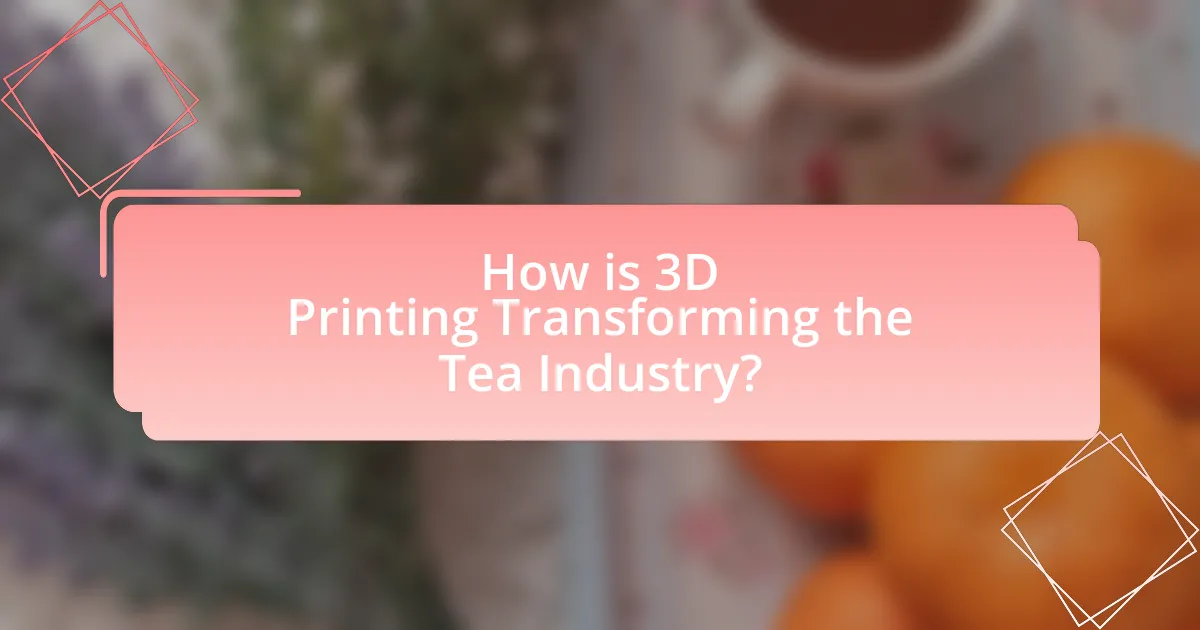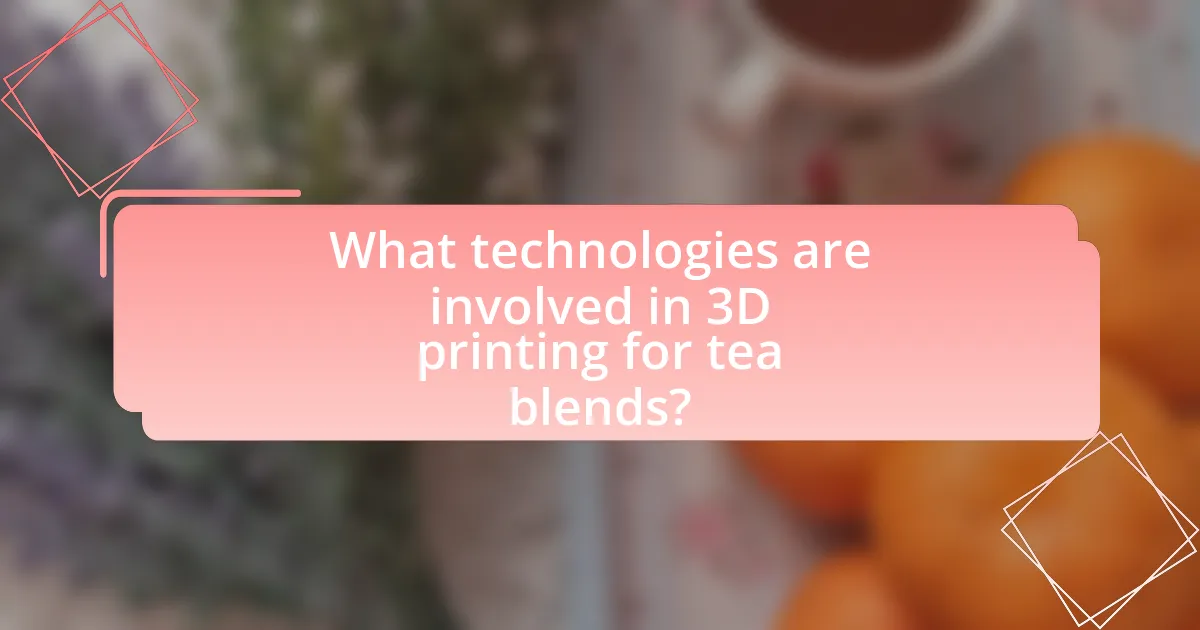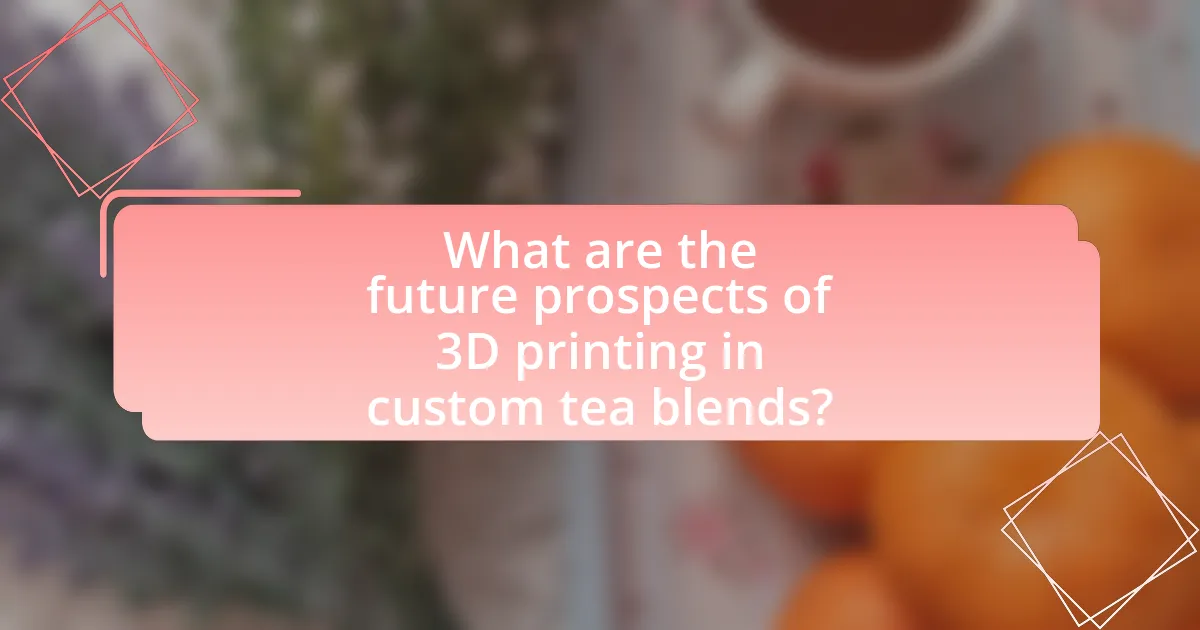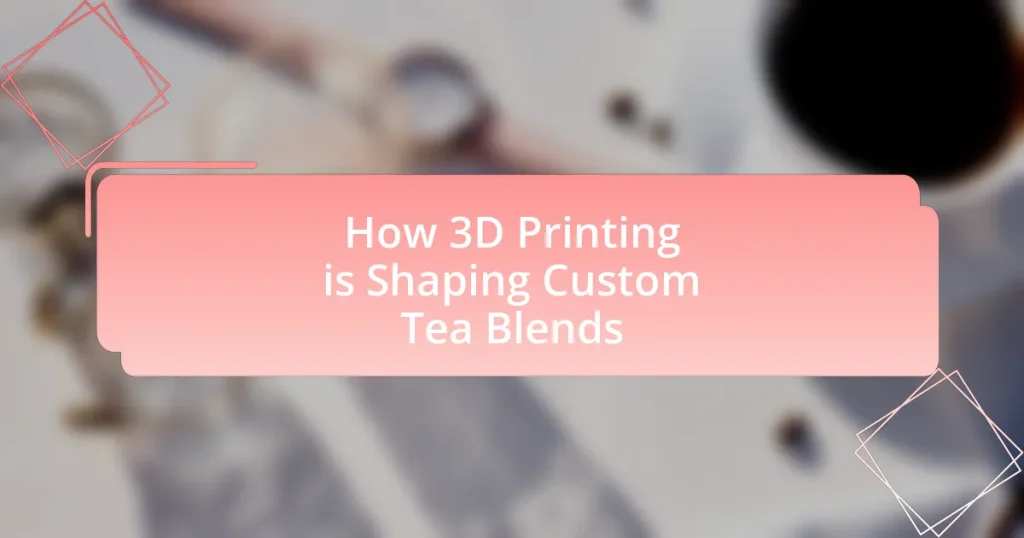The article examines how 3D printing is revolutionizing the tea industry by enabling the creation of customized tea blends that cater to individual preferences. It highlights the technology’s role in formulating unique tea compositions, enhancing flavor profiles, and streamlining production processes. Key advantages include personalization, efficient manufacturing, and innovative design capabilities, which align with the growing consumer demand for tailored tea experiences. The article also discusses emerging trends, challenges in implementation, and future prospects for 3D printing in the tea market, emphasizing the importance of customization and sustainability in consumer choices.

How is 3D Printing Transforming the Tea Industry?
3D printing is transforming the tea industry by enabling the creation of customized tea blends tailored to individual preferences. This technology allows producers to design and manufacture unique tea compositions with precise control over ingredients, flavors, and packaging. For instance, companies can utilize 3D printing to produce intricate tea infusers that enhance the brewing process, ensuring optimal extraction of flavors. Additionally, 3D printing facilitates rapid prototyping of new tea products, allowing brands to quickly respond to market trends and consumer demands. This innovation not only streamlines production but also enhances the overall consumer experience by offering personalized tea solutions.
What role does 3D printing play in creating custom tea blends?
3D printing plays a significant role in creating custom tea blends by enabling the precise formulation and production of unique tea ingredients and packaging. This technology allows for the customization of tea blends at a molecular level, where specific flavor profiles and health benefits can be tailored to individual preferences. For instance, 3D printing can create intricate tea capsules that contain exact measurements of various herbs and flavors, ensuring consistency and enhancing the user experience. Additionally, the ability to produce biodegradable packaging through 3D printing aligns with sustainable practices, appealing to environmentally conscious consumers.
How does 3D printing enhance the flavor profiles of tea blends?
3D printing enhances the flavor profiles of tea blends by allowing for precise customization of ingredients and their proportions. This technology enables the creation of intricate flavor combinations that traditional blending methods cannot achieve, as it can layer different tea components and flavoring agents in specific ratios and structures. For instance, 3D printing can incorporate flavor-infused materials, such as encapsulated herbs or spices, directly into the tea blend, ensuring a more uniform distribution of flavors. This method has been shown to improve the overall sensory experience, as evidenced by studies demonstrating that customized blends can lead to heightened aroma and taste profiles, ultimately resulting in a more enjoyable tea-drinking experience.
What are the advantages of using 3D printing for tea customization?
The advantages of using 3D printing for tea customization include enhanced personalization, efficient production, and innovative design capabilities. Enhanced personalization allows consumers to create unique tea blends tailored to their specific tastes, as 3D printing can produce customized tea shapes and flavors based on individual preferences. Efficient production is achieved through the ability to quickly prototype and manufacture small batches of tea products, reducing waste and time compared to traditional methods. Innovative design capabilities enable the creation of complex tea structures, such as intricate tea infusers or unique packaging, which can enhance the overall tea experience. These advantages collectively contribute to a more engaging and tailored tea consumption experience.
Why is customization important in the tea market?
Customization is important in the tea market because it allows consumers to tailor their tea experiences to personal preferences, enhancing satisfaction and loyalty. The growing trend of personalized products reflects a shift in consumer behavior, where 70% of consumers express a preference for customized options over standard offerings. This demand for unique blends drives innovation and competition among tea brands, leading to the adoption of technologies like 3D printing, which facilitates the creation of bespoke tea blends efficiently and cost-effectively.
How do consumer preferences drive the demand for custom tea blends?
Consumer preferences significantly drive the demand for custom tea blends by influencing the types of flavors, health benefits, and personalization options that consumers seek. As consumers increasingly prioritize unique experiences and health-conscious choices, they gravitate towards custom blends that cater to their specific tastes and dietary needs. For instance, a survey by the Tea Association of the USA indicated that 60% of tea drinkers are interested in trying new flavors, highlighting a strong market for personalized tea options. This trend is further supported by the rise of online platforms that allow consumers to create their own blends, reflecting a shift towards customization in the beverage industry.
What trends are emerging in the custom tea blend market?
Emerging trends in the custom tea blend market include the increasing demand for personalized flavors, health-focused ingredients, and sustainable sourcing practices. Consumers are increasingly seeking unique blends tailored to their individual tastes and health benefits, such as adaptogens and functional herbs. Additionally, the rise of eco-conscious consumers is driving brands to adopt sustainable practices, including biodegradable packaging and ethically sourced ingredients. According to a report by Grand View Research, the global herbal tea market is projected to grow significantly, indicating a shift towards more customized and health-oriented tea options.

What technologies are involved in 3D printing for tea blends?
The technologies involved in 3D printing for tea blends include selective laser sintering (SLS), fused deposition modeling (FDM), and binder jetting. SLS utilizes a laser to fuse powdered materials, allowing for the creation of complex shapes and structures that can incorporate various tea ingredients. FDM involves extruding thermoplastic materials, which can be infused with tea flavors, to build up layers, enabling customization of tea blend designs. Binder jetting applies a liquid binder to layers of powdered tea materials, facilitating the formation of intricate tea blend shapes. These technologies enable precise control over the composition and structure of tea blends, enhancing personalization and innovation in tea production.
How does the 3D printing process work for tea blends?
The 3D printing process for tea blends involves creating customized tea compositions by layering materials that represent different tea ingredients. Initially, powdered tea leaves, herbs, and flavorings are prepared and mixed according to a specific recipe. The 3D printer then deposits these materials layer by layer, using a binding agent to fuse them together, forming a solid structure that encapsulates the desired flavor profile. This method allows for precise control over the blend’s composition, enabling the creation of unique tea experiences tailored to individual preferences. The accuracy of this process is supported by advancements in 3D printing technology, which can achieve intricate designs and consistent quality in the final product.
What materials are used in 3D printing custom tea blends?
3D printing custom tea blends primarily utilizes food-safe polymers and edible materials such as sugar, starch, and gelatin. These materials are chosen for their ability to be processed in 3D printers while maintaining safety for consumption. For instance, sugar can be used to create intricate designs and flavor profiles, while starch and gelatin can provide structure and texture to the final product. The use of these materials allows for the precise layering and customization of tea blends, enhancing both the aesthetic and sensory experience of the tea.
How does the technology ensure consistency in tea blend production?
Technology ensures consistency in tea blend production by utilizing precise measurement and automated mixing processes. Advanced 3D printing techniques allow for the exact replication of tea blend recipes, ensuring that each batch maintains the same flavor profile and quality. This is achieved through the integration of sensors and software that monitor ingredient ratios and environmental conditions during production, thereby minimizing human error and variability. Studies have shown that automated systems can reduce inconsistencies by up to 30%, leading to a more reliable product for consumers.
What are the challenges of implementing 3D printing in tea blending?
The challenges of implementing 3D printing in tea blending include material compatibility, precision in flavor profiles, and regulatory compliance. Material compatibility is crucial because not all tea ingredients can be effectively printed, limiting the range of blends that can be created. Precision in flavor profiles is essential, as 3D printing must accurately replicate the desired taste and aroma, which can be difficult to achieve with current technology. Regulatory compliance poses another challenge, as food safety standards must be met, requiring thorough testing and validation of the 3D printing process and materials used. These challenges highlight the complexities involved in integrating 3D printing into the tea blending industry.
What technical limitations exist in current 3D printing technologies?
Current 3D printing technologies face several technical limitations, including material constraints, speed, resolution, and scalability. Material constraints arise because not all materials can be effectively used in 3D printing, limiting the range of products that can be created; for example, many printers are restricted to plastics and metals, which may not be suitable for all applications. Speed limitations are evident as most 3D printers operate at slower rates compared to traditional manufacturing methods, making them less efficient for large-scale production. Resolution issues can affect the detail and finish of printed objects, as many printers struggle to achieve the fine precision required for intricate designs. Finally, scalability is a challenge, as transitioning from prototyping to mass production often requires significant investment in more advanced equipment, which can be a barrier for many businesses. These limitations collectively hinder the full potential of 3D printing in various industries, including the customization of products like tea blends.
How can businesses overcome these challenges?
Businesses can overcome challenges in adopting 3D printing for custom tea blends by investing in training and technology. By providing employees with comprehensive training on 3D printing techniques and software, businesses can enhance their operational efficiency and creativity in product development. Additionally, investing in high-quality 3D printers and materials tailored for food applications ensures that the final products meet safety and quality standards. Research indicates that companies that prioritize employee education and advanced technology see a 30% increase in productivity and innovation, which supports the successful integration of 3D printing into their processes.

What are the future prospects of 3D printing in custom tea blends?
The future prospects of 3D printing in custom tea blends are promising, as this technology allows for the precise formulation and personalization of tea ingredients. With advancements in 3D printing techniques, manufacturers can create complex flavor profiles and textures that cater to individual preferences, enhancing the consumer experience. For instance, companies like Print-a-Tea have already begun experimenting with 3D-printed tea blends, showcasing the potential for on-demand customization. Additionally, the ability to incorporate health supplements and functional ingredients into tea blends through 3D printing could lead to innovative products that meet specific dietary needs. As consumer demand for personalized products continues to rise, the integration of 3D printing in the tea industry is likely to expand, driving growth and innovation.
How might 3D printing evolve in the tea industry?
3D printing may evolve in the tea industry by enabling the creation of customized tea blends and packaging tailored to individual preferences. This technology allows for precise control over the composition of tea blends, facilitating the incorporation of various ingredients such as herbs, spices, and flavors in specific ratios. For instance, companies like Tea & Coffee Trade Journal have reported on advancements in additive manufacturing that can produce intricate tea bags and unique flavor profiles, enhancing consumer experience. Additionally, 3D printing can streamline production processes, reduce waste, and allow for on-demand manufacturing, which aligns with the growing trend of personalization in food and beverage sectors.
What innovations are on the horizon for 3D printed tea blends?
Innovations on the horizon for 3D printed tea blends include the development of customizable flavor profiles and the integration of health-enhancing ingredients. Advances in 3D printing technology allow for precise layering of different tea components, enabling consumers to create personalized blends that cater to individual taste preferences and dietary needs. Research indicates that companies are exploring the use of natural extracts and functional additives, such as vitamins and adaptogens, to enhance the nutritional value of these blends. This trend is supported by the growing consumer demand for personalized health solutions and unique flavor experiences in the beverage market.
How will consumer behavior influence the future of 3D printed tea?
Consumer behavior will significantly influence the future of 3D printed tea by driving demand for personalized and sustainable products. As consumers increasingly seek unique flavors and health benefits, the ability to customize tea blends through 3D printing will cater to these preferences, allowing for tailored experiences that traditional tea production cannot offer. Additionally, the growing trend towards sustainability will push consumers to favor 3D printed tea that minimizes waste and utilizes eco-friendly materials, aligning with their values. This shift is supported by market research indicating that 70% of consumers are willing to pay more for sustainable products, highlighting the potential for 3D printed tea to thrive in a market that prioritizes personalization and environmental responsibility.
What best practices should businesses follow when using 3D printing for tea blends?
Businesses should prioritize material selection, design optimization, and quality control when using 3D printing for tea blends. Selecting food-safe materials ensures that the printed components do not contaminate the tea, while optimizing designs for efficient printing can enhance the aesthetic and functional qualities of the blends. Implementing rigorous quality control measures, such as regular testing of printed products for consistency and safety, is crucial to maintain product integrity. These practices are supported by industry standards that emphasize food safety and product reliability in additive manufacturing.
How can companies ensure quality control in 3D printed tea products?
Companies can ensure quality control in 3D printed tea products by implementing rigorous testing protocols throughout the production process. This includes conducting material analysis to verify the quality of the filament used for printing, as well as performing dimensional accuracy checks to ensure that the printed products meet specified design tolerances. Additionally, companies should establish a standardized quality assurance process that includes regular inspections and testing of the final products for safety and compliance with food-grade standards. Research indicates that maintaining a controlled environment during the printing process can also significantly reduce defects, thereby enhancing overall product quality.
What strategies can enhance customer engagement with custom tea blends?
To enhance customer engagement with custom tea blends, businesses can implement interactive online platforms that allow customers to create and personalize their blends. This strategy fosters a sense of ownership and connection to the product. For instance, companies like Adagio Teas utilize user-friendly interfaces where customers can select ingredients based on flavor profiles, health benefits, and personal preferences, resulting in a tailored experience. Additionally, offering educational content about the origins and benefits of each ingredient can deepen customer knowledge and interest, as seen in successful brands that provide detailed descriptions and brewing tips. Engaging customers through social media campaigns that encourage sharing their custom blends can also amplify community involvement and brand loyalty.


